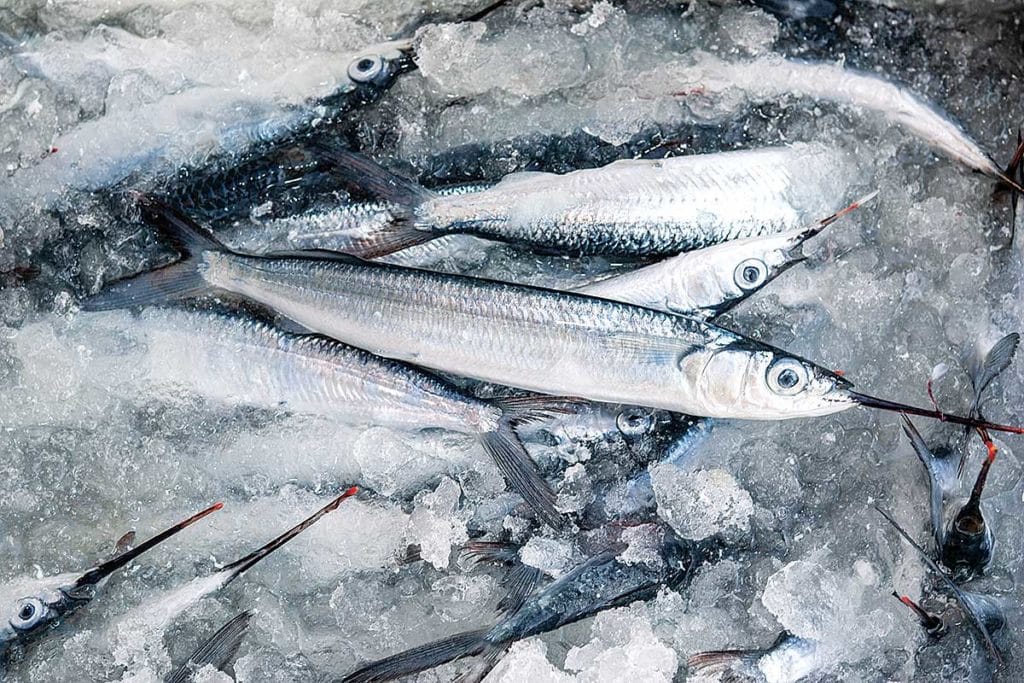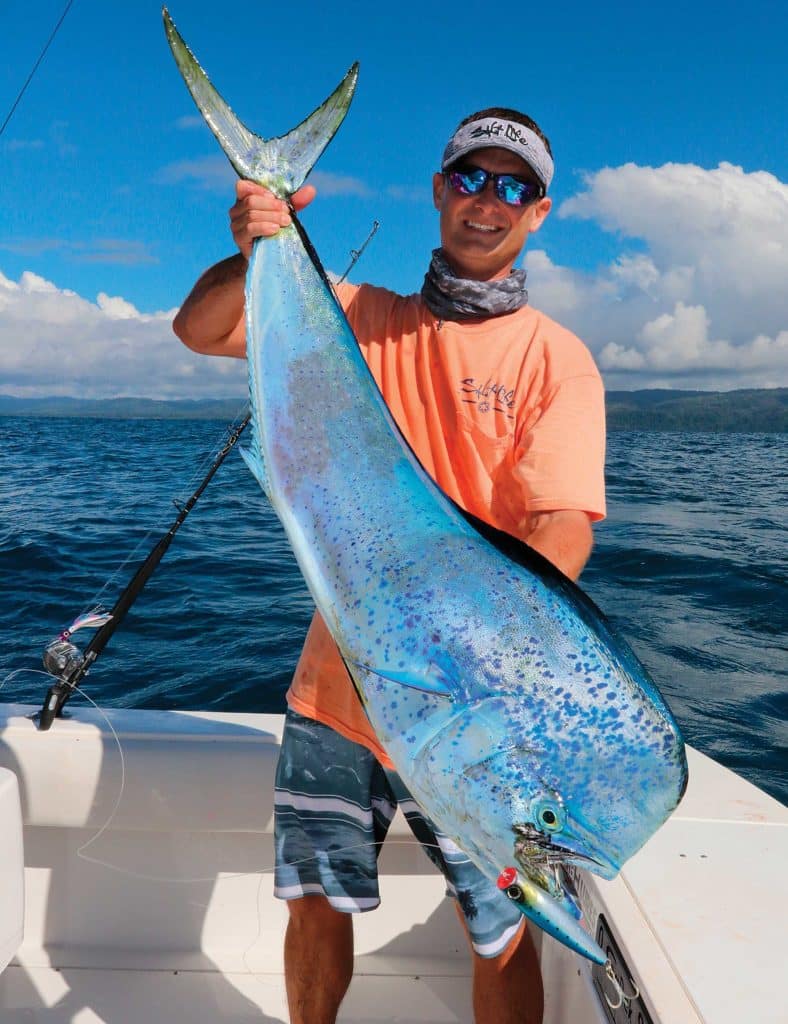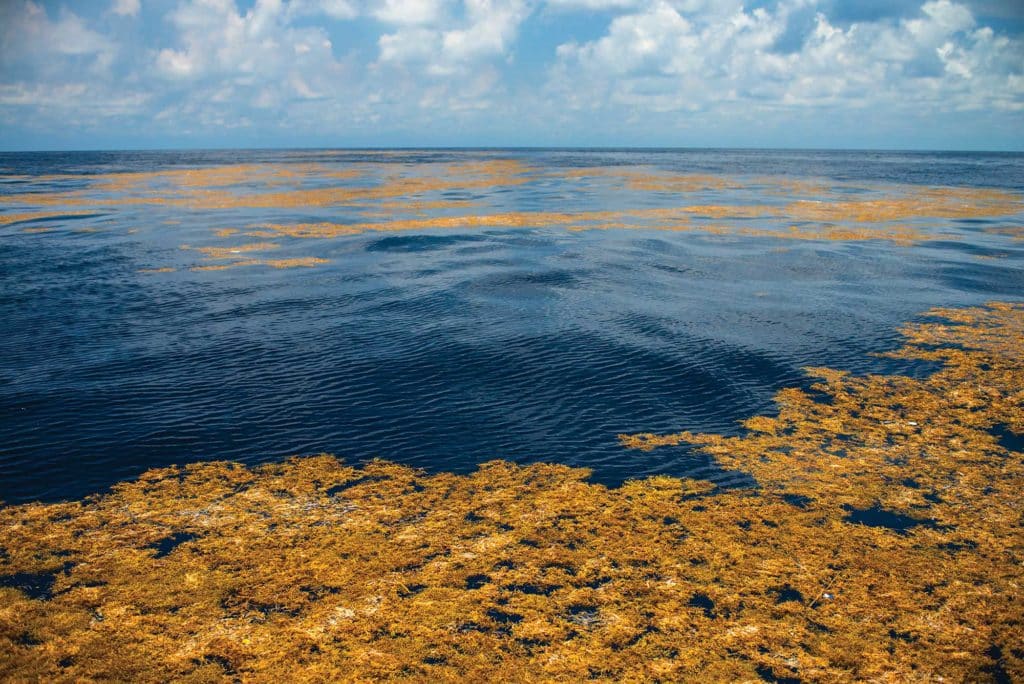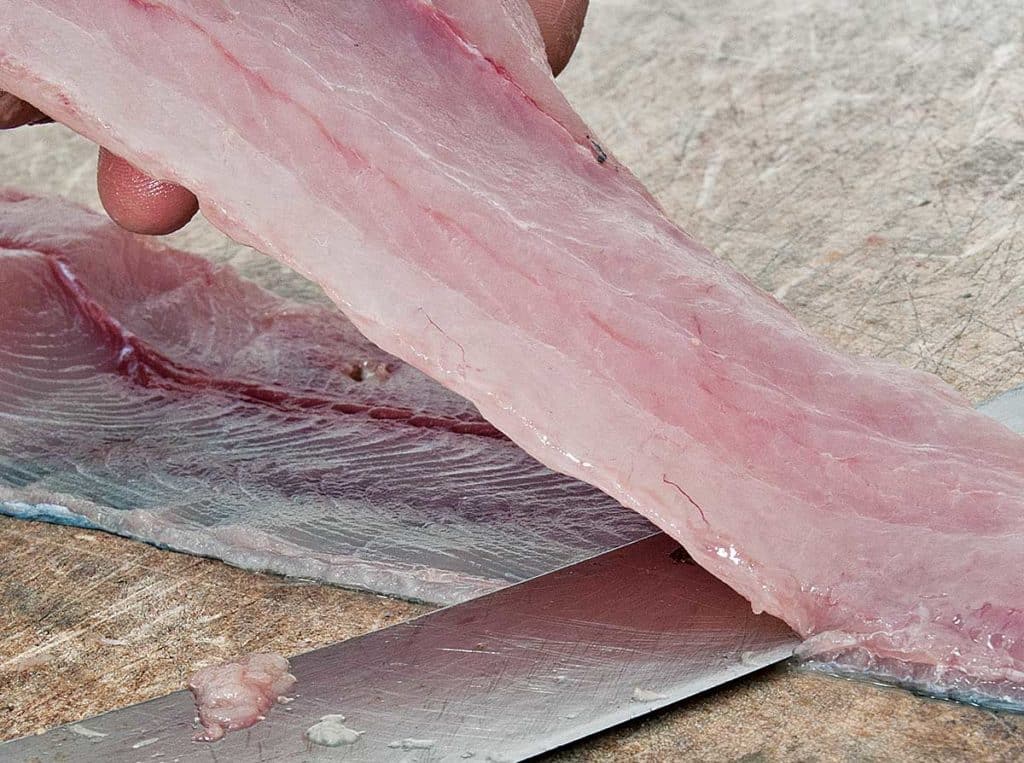
The hard-fighting, acrobatic, colorful and tasty Coryphaena hippurus ranks among the most sought species in the Florida Keys. It’s no wonder, then, that Keys charter captains are particularly adept at catching them. Whether they’re trolling along weed lines or in the open ocean, sight-casting to fish on floating debris, or even plucking them from above using a kite, four pro skippers — operating out of Key Largo, Islamorada, Marathon and Key West — share their strategies to locate and capture this neon-blue-and-brilliant-gold treasure.

In Open-Ocean Waters
“When there is no weed line or debris to fish on, look at sea-surface-temperature charts,” says Compass Rose skipper and 30-year Key West charter veteran Capt. Mike Weinhofer (fishnkw.com). Dolphin typically follow temperature breaks until they find sargassum weed or bait, so that’s a good starting point.
“You also have to cover ground,” he adds. “I can troll ballyhoo around 6 knots. I cover 30 percent more ground trolling artificials up to 9 knots. That should equate to 30 percent more fish.”
Early in spring, when large, fast-moving and sometimes-finicky dolphin predominate, Weinhofer trolls a combination of medium ballyhoo and small lures, but when school-size fish show up, from April through October, he trolls four to six artificials.
“Choose small lures with a lot of action, such as a 4-inch, hard Williamson Dorado Catcher. You want to make as much noise as possible,” Weinhofer says. He trolls two flat lines and two rigger lines as fast as lures allow, so they’re popping and skipping but not jumping and tumbling — 8 knots or more. “I put a 4-inch Williamson Sailfish Catcher way back in the shotgun; it’s often deadly for small tuna and lingering dolphin.”

Keys captains also know dolphin swim deep at times. “If the water is very warm, or the wind just switched direction, replace a flat line with a deep-diving lure such as a Rapala Magnum 30 or 40. Run it right at the edge of the prop wash down 20 or 30 feet,” Weinhofer says. If conditions allow, he runs a flat line above it. “They come off that deep Magnum, almost like a dredge, and eat the surface lure.”
Capt. Frank Navarro grew up fishing off Key Largo and now charters Mr. Nice from Ocean Reef Club at the northernmost edge of the island (oceanreef.com). “If there is no weed, I’ll put out six lines plus teasers,” he says, favoring small lures or feathers for dolphin and tuna, and teasers to interest marlin, plus a chugger or skirt over a ballyhoo on a flat line. He trolls this spread at 7 or 8 knots, or if using lures without ballyhoo, at 9 or 10 knots.
When nothing that might attract fish shows on the surface, Navarro trolls along a depth contour. If he doesn’t find encouraging signs, then he pushes offshore to 100 feet deeper, and follows that depth for a while, then moves farther offshore again. “Watch for birds, or look for any little edge, even if it doesn’t have any weed on it,” he says.

Classic Keys Sight-Fishing
Fortunately, summertime trade winds in the Keys almost invariably produce something on the surface along which one can troll. “If it’s overcast, I’ll put out a full spread,” says Islamorada charter skipper Capt. Alex Adler (budnmarys.com). Aboard his boat, Kalex, that means small lures, Japanese feathers, bonito (little tunny) strips or naked ballyhoo. “If it’s rough, I’ll add chuggers or skirts with a little weight.”
On sweltering, slow-fishing days, Adler — who’s been fishing here for 45 years — often adds a cigar lead or planer to one flat line, 20 feet ahead of a ballyhoo. “It doesn’t have to be deep,” he says. “Getting it down 15 feet draws them up. That deep one will go off first, then they eat the surface baits.” Another tip to draw in fish: “Spray your washdown hose high up in the air,” mimicking a showering school of ballyhoo.
When skies are bright, most Keys captains stalk dolphin from their towers. “Even if it’s just a thin, broken weed line, I’ll put out a couple of baits so we’re fishing something — maybe a strip bait with a little head to keep it in the water, and a Japanese feather so I can pull them fast when I need to — but we’re focusing on sight‑fishing,” Adler says. “You might run for miles with nothing, not even seeing any bait, and then you find a sweet spot — maybe a hatch with little 1-inch bait — and the dolphin are thick.”
Read Next: Mahi Species Page
Exactly where those honey holes swarming with dolphin might be depends largely on the wind. “An east or southeast wind is best in the Keys,” says Capt. Marty Lewis, who operates Main Attraction (mainattraction.org) from Marathon. As wind blows sargassum weed and bait closer to shore, dolphin come in with it. The stronger the breeze, or the longer it’s been blowing toward shore, the closer to land the fish will be.
“When you think you’re in the zone, slow down so you don’t miss anything,” Lewis says. While sight-fishing, he usually trolls just two lines from his riggers. “We see nine out of 10 dolphin before they find the rigger baits, and if you miss a fish, you can turn and get back to it a lot easier.” He prefers to fish bait, though. “Dolphin seem to throw the hooks more with lures, and big dolphin don’t turn down ballyhoo,” which he trolls naked between 5 and 7 knots.
When he wants to cover ground, Lewis switches to small bonito strips behind pink-and-blue or yellow-and-green skirts — colors he says dolphin associate with flying fish and small jacks often found in sargassum — or simply puts out no trolled bait in favor of strictly sight-fishing.

Birds
All four skippers say understanding birds is key to dolphin success. “If you see 30 or 40 birds, it’s a good bet they’re not over dolphin,” Lewis says. Ten birds, or even two, are a much better sign. “They need to be staying in one area, not jumping all over the place.”
“Mahi are usually feeding into the current, moving south slowly,” Navarro says of the northward Gulf Stream current off the upper Keys. “They don’t race around the way tuna do. Fish moving faster than you can catch at trolling speed are probably not mahi.”
When stalking a promising flock of birds, Navarro says: “Approach with the sun behind you so you can see the fish. Troll by and cast any kind of live bait out to the school, or throw out a dead ballyhoo and retrieve it like a lure, skipping it right back to the boat,” which often draws the school into his trolled spread.
“Frigate birds fly into the wind, but they dive with the wind,” Weinhofer says, which means birds are watching fish somewhat behind (downwind of) them. Also, birds fly higher when fish are deeper, and fly lower as fish move toward the surface. “You want to parallel the direction the birds are moving, then lay off a hundred yards, and wait. As the birds get lower, put your lures right under them. That’s another advantage to artificials. I can speed up and time it just right without washing out baits.”

Weed Lines
When southeasterly trade winds are steady for a few days, scattered weed and bait move with the wind until they hit a water-temperature change. Cooler water sinks where it meets warmer water, and that process gathers weed into miles-long lines where dolphin forage.
“I generally fish the offshore side, but you have to fish the cleanest edge,” Weinhofer says, meaning the best-formed edge of the weed line, with less loose weed to catch hooks. This can change during the day. “As the tide goes in, it tends to break up the weed line. As the tide goes out, it tightens up the edge,” Weinhofer says.
Weinhofer, fishing from a 37-foot center-console without the benefit of a high tower, pulls a full spread even among broken weed. “Trolling artificials, I can speed up past 10 knots and usually knock the weed off the hooks.” He also offers this advice: “If the gap in the hook is bigger than the size of the lure head, it catches a lot more weed.” Shorten up trolling spreads too. “With lures closer to the boat, there is less line in the water to catch weed.”
“I’d rather fish two clean flat lines directly behind the boat than try to pull more,” Navarro says. “I’ll put up with more weed to troll with the sun at my back so I can sight-cast to swimming fish. Mahi will come under a weed line to hit a bait.”

Debris
Locating the right piece of floating debris often means finding the mother lode of dolphin — and often wahoo too.
“We’ll troll two rigger baits right by a piece of debris, but dolphin stand out like a sore thumb from the tower, so we usually hook fish by pitching a live bait before we hook one on a rigger,” Lewis says.
“Troll some distance around debris. They could be 500 yards away,” Adler says. “In addition, they could be deep. Stop the boat and let the lures or baits sink down, then bump the boat ahead. That often brings them up.”
“I troll a full spread in a figure eight around anything floating, definitely with the [diving] Magnum,” Weinhofer says, which he rigs with 15 feet of 50-pound fluorocarbon leader. “Wahoo always eat the tail hook,” he says. “The only ones I lose are when another wahoo hits the same lure.”
“We catch 90 percent of our wahoo under debris,” Lewis says. “First catch whatever dolphin you can, then set up a wahoo rod and troll by it as close as you can at 14 knots,” he says, using high-speed wahoo trolling lures on a wire line with a planer or with trolling leads. “Always try trolling by from the opposite direction too.”
“The smallest Vortex speed jig is awesome for wahoo and dolphin,” Weinhofer says. “Drop it right next to debris and count to 30, then retrieve a long sweep up, drop the rod tip down, and crank two or three cranks.” The same technique entices bites from dolphin holding deep after a sudden wind shift or in very warm water.

Mahi Melee
“When you hook up trolling, you don’t need to circle back,” Lewis says. “Immediately throw out a live bait while you clear your other lines. If there are other fish out there, they’ll come in.” That might be a few followers or a school of dozens of frenzied fish.
“Once you hook one, keep it 5 or 10 feet out from the boat, just close enough that it can’t get into the motors,” which keeps the school interested, Weinhofer says. “Pull it back and forth to make it jump. That gets the school fired up.” Boat that fish as you reel another hooked fish alongside, always keeping one in the water.
When dolphin congregate near debris, Navarro says: “Pull up nice and easy, and throw pitch baits on spinning rods. Bonito, squid and ballyhoo all work for schoolies when cut up in pieces. If you see a bigger fish, throw a whole ballyhoo and twitch it.”
Whether along weed lines or in open water, “keep the boat moving in the direction the fish are moving,” Adler says. He often throws a chum bag over the side. “Feed them little pieces of bait or they lose interest.”
“A cow will grab a live ballyhoo by the head and spit out the tail for the bull,” Weinhofer adds. “Feed them a few ballyhoo heads, and then put a hook in a tail. You’ll catch more bulls that way.”
Read Next: Fly Fishing Offshore Weed Lines
Keeping Up the Bite
Dolphin often fade after the first initial frenzy. “Break the bill off a whole ballyhoo and hook it upward through the center of the head, just behind the eyes. Cast it out and retrieve just fast enough to skip it across the surface. If they won’t eat anything else, skip a whole squid across the surface,” Weinhofer says, “or throw out a netful of live bait to get them fired up, but never [use] live ballyhoo. Dolphin chase them all over the ocean and never come back.”
“Use a sabiki rig to catch bait from the debris or weed,” Navarro adds. “If you have nothing else, throw a little bucktail and jig it fast for a reaction bite.”
Kites
Dolphin aren’t targeted with kites because they limit the extent of territory that boats can travel, but big dolphin often come into kite spreads, and trying to hook them on circle hooks used while sailfishing can be frustrating. “Dolphin don’t bite fish in half. They mash it with the top of their mouth. That mashes the circle hook into the bait,” Weinhofer explains.
“In summer, they’ll stick around in the kite spread,” Navarro says. “Throw spinners with dead bait on J hooks, or maybe a live bait for a really big one. In winter or early spring, the fish show up in the spread and then they’re gone,” he says, providing just one quick shot at hooking them. “Let them eat the kite bait, but come tight on circle hooks really slowly.”
“Your hookup percentages are always better with a dead bait,” Adler says. “You’ll get more bites with live bait, but the dolphin chase live bait so aggressively that they knock it off the hook more often. They also jump and throw the hook less often when eating dead bait.
“Keep spinners ready. Wind that kite bait out of the water and pitch a dead bait,” he continues. He prefers halved or quartered baits for smaller fish, and whole baits for larger fish. Adler offers one caveat: “Big fish in the wintertime definitely prefer live bait.”
Whether it’s one 50-pound bull and a following cow, or a school of 5-pound peanuts, hooking dolphin always provides a thrill. “When they school up behind the boat, it’s interactive,” Weinhoffer says.
“The whole family, even small children, are catching them,” Adler adds.
“It’s chaos,” Navarro says. “Great fun even once you start throwing them back!”

More than One Way to Skin a Dolphin
In the laid-back Florida Keys, any name — mahimahi, dorado, dolphin or the recently-in-vogue dolphinfish — is perfectly fine, but whatever they call Coryphaena hippurus, Keys captains have strong opinions on how to skin them.
“I pull the skin. It’s easier,” Lewis says. He makes a shallow cut around the perimeter of the fillet, then grabs the front upper corner of skin with pliers, and pulls. “The membrane that’s left behind is gone once you cook it. If it’s a large bull with tough skin, split the fillet along the spine, and pull it off in two pieces.”
“I never pull the skin. It makes the meat bitter,” Weinhofer says, because, he maintains, the flavor stays in the fillet even after the white, fibrous skin membrane cooks away. He prefers instead to run a wide, sharp knife parallel to the cleaning table, not angled down toward the skin as when skinning most species.
“It’s just as fast to cut off the skin,” Navarro says. “The fillet looks better, and pulling the skin makes a huge mess. It takes practice though.”








